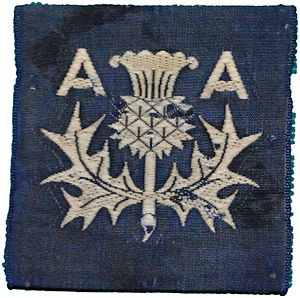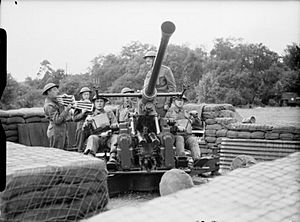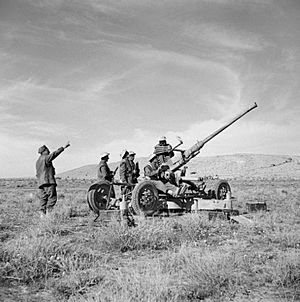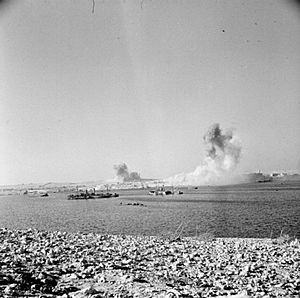1st Linlithgowshire Rifle Volunteers facts for kids
Quick facts for kids 1st Linlithgowshire Rifle Volunteers8th Volunteer Battalion, Royal Scots 10th (Cyclist) Battalion, Royal Scots 14th (West Lothian, Royal Scots) LAA Rgt, RA 514 (West Lothian, Royal Scots) LAA Rgt, RA |
|
|---|---|
| Active | 19 March 1860–1967 |
| Country | |
| Branch | |
| Role | Infantry Cyclist Air Defence |
| Part of | Royal Scots Anti-Aircraft Command Eighth Army |
| Garrison/HQ | Linlithgow |
| Engagements | Second Boer War World War I |
The 1st Linlithgowshire Rifle Volunteers was a Scottish military group formed in Linlithgow in 1860. It was made up of volunteers who trained part-time to help the regular army. This unit later became a special "cyclist battalion" of the Royal Scots regiment. They helped defend Britain during World War I and even fought in Russia.
After World War I, the unit became smaller. But just before World War II, it changed into an anti-aircraft (AA) regiment. This new unit joined the Royal Artillery (RA). They helped protect Britain from air attacks during the Blitz. They also bravely fought in the Siege of Tobruk and throughout the Italian Campaign. The unit continued to serve in the Territorial Army (TA) until 1967.
Contents
Becoming a Volunteer Force Unit
In 1859, many people in Britain were worried about a possible invasion. This led to a big wave of excitement for the "Volunteer movement." People wanted to join groups of part-time soldiers called Rifle Volunteer Corps (RVCs). These volunteers were ready to support the regular British Army if needed.
One of these new groups was the 1st Linlithgowshire Rifle Volunteers. It was a company formed in Linlithgow, the main town of West Lothian, on March 19, 1860. Captain Robert Stewart was in charge. Soon, other companies formed in nearby towns in West Lothian. These companies then joined together to form the 1st Administrative Battalion of Linlithgowshire Rifle Volunteers on October 21, 1862. Major Stewart was promoted to lead them.
- The 1st Linlithgowshire RVC started in Linlithgow in March 1860.
- The 2nd Linlithgowshire RVC began in Bo'ness in March 1860.
- The 3rd Linlithgowshire RVC formed in Bathgate in April 1860. It later moved to Torphichen in 1864.
- The 4th Linlithgowshire RVC was created in Bathgate in August 1862. It was made up of workers from Young's Chemical Works.
- The 5th Linlithgowshire RVC started in Uphall in January 1870.
- The 6th Linlithgowshire RVC formed in West Calder in April 1878.
In 1880, these RVCs were officially combined. The 1st Administrative Battalion became the 1st Linlithgowshire Rifle Volunteers on March 16. Each RVC became a lettered company within this new battalion. For example, part of the 6th RVC became F Company at Addiewell. The rest of the 6th became G Company at West Calder. C Company moved to Armadale the next year.
Joining the Royal Scots Regiment
In 1881, the 1st Linlithgowshire unit officially joined the Royal Scots regiment. On July 1, it became a Volunteer Battalion of the Royal Scots. In April 1888, it was formally renamed the 8th Volunteer Battalion, Royal Scots.
This battalion was part of the "Forth Brigade." This brigade helped organize training for volunteer units. In 1902, the Forth Brigade split. The 8th Volunteer Battalion then became part of the 2nd Lothian Brigade.
Serving in the Boer War
Thirty-six volunteers from the battalion served in the Second Boer War (1899-1902). They mainly fought with other Royal Scots volunteer companies. Their service earned the battalion its first special honor: South Africa 1900–02.
Around 1900, the battalion added three new companies. One was a special Cyclist Company.
Becoming a Cyclist Battalion
In 1908, the Volunteer Force changed into the new Territorial Force (TF). The battalion was reorganized to become the 10th (Cyclist) Battalion, Royal Scots. It had eight companies and its main office was in Linlithgow.
Cyclist battalions were not part of the main army divisions. Instead, they were "Army Troops" kept at a higher command level. The 10th (Cyclist) Battalion, Royal Scots, was under Scottish Command.
World War I Service
When World War I started on August 4, 1914, the battalion was called into action. They were sent to defend the coast at Berwick-upon-Tweed.
Soon, TF units were asked to volunteer to serve overseas. Many men volunteered. So, a "2nd Line" unit was formed for each TF unit. These new units had the same name but with a "2/" in front. For example, the 2/10th Royal Scots was formed in September. It was filled with new volunteers very quickly. Later, "3rd Line" training units were also created.
Defending the Coast
From November 1914, cyclist battalions became part of the new Army Cyclist Corps. The 1/10th (Cyclist) Battalion Royal Scots was joined by the 2/10th at Berwick in January 1915. Both battalions stayed there until 1918. They were then moved to Ireland. The battalion was finally disbanded in February 1920.
Fighting in North Russia
By 1918, the 2/10th Battalion had sent many soldiers overseas. It was mostly made up of men who were not fully fit for frontline combat. However, the army needed troops for a special force in North Russia. The 2/10th was reorganized as an infantry battalion. It received new soldiers from other units in Ireland. In July 1918, it returned to England. Then, it sailed to Arkhangelsk as part of the force, arriving in late August 1918.
One company stayed in Arkhangelsk. The rest of the battalion operated along the Northern Dvina River. This area was difficult to move through because of marshes and forests. But with help from a Royal Navy ship, the Royal Scots cleared an area between two rivers. They captured several villages and prisoners.
One village, Pless, was very well protected. So, A Company tried to go around it through the marshes. The next morning, they reached Kargonin, behind Pless. The defenders thought they were surrounded by a large force. So, they left both villages. This was a remarkable march for troops who were not fully fit.
By late September, the battalion reached Nijne-Toimski. This place was too strong for the Allied force. So, they set up a defensive line. The ship supporting them had to leave before the river froze. The force was then attacked by enemy gunboats. They moved to a second defensive line for the winter. With help from Canadian artillery, they fought off many attacks. A very heavy attack happened on November 11. The 2/10th Royal Scots was then joined by the company from Arkhangelsk. The force settled into villages and log blockhouses for the winter. They also trained and carried out raids on snowshoes, skis, and sledges.
The enemy started attacking again in early 1919. A Company had to reinforce a group on the Vaga River. They marched over 50 miles in temperatures far below freezing. The enemy now had more artillery. Also, local people did not rise up against the enemy as hoped. Some friendly Russian troops mutinied in April. American troops were withdrawn in May. Still, the force stayed in position. The 2/10th Royal Scots was replaced by other British troops. The battalion returned to Arkhangelsk by boat and sailed home on June 10. They arrived in Leith and were immediately disbanded on June 25.
Between the World Wars
When the Territorial Army (TA) was reformed in 1920, the 10th (Cyclist) Battalion changed. First, it became the 1st (Linlithgow) Light Bridging Company of the Royal Engineers. Then, in 1921, it became A Company of the 4/5th (Queen's Edinburgh Rifles) Battalion, Royal Scots in Edinburgh. The Company HQ stayed in Linlithgow.
Becoming an Anti-Aircraft Regiment
In the 1930s, Britain needed better anti-aircraft (AA) defenses for its cities. So, some TA infantry battalions were turned into AA units. The 4th/5th Royal Scots was one of them. It became a searchlight regiment in 1938.
At the same time, the TA doubled in size. A Company became the basis for a new unit: the 14th (West Lothian, Royal Scots) Light Anti-Aircraft Regiment of the Royal Artillery (RA). The Linlithgow company formed the Regimental HQ (RHQ). It also formed 39 (Linlithgow) and 40 (Bathgate) LAA Batteries. Two more batteries, 57 LAA Battery and 58 LAA Battery, were raised in 1939.
World War II Service
Getting Ready for War
The 14th (West Lothian) LAA Regiment was part of the 3rd AA Division. This division was responsible for defending Scotland. In February 1939, all TA AA defenses came under a new group called Anti-Aircraft Command.
Before the war officially started, some TA units began to mobilize. They took turns manning important AA positions. On August 24, just before war was declared, AA Command fully mobilized. The 14th (West Lothian) LAA Regiment joined the 51st Light Anti-Aircraft Brigade. This brigade was formed in August 1939 to handle all light anti-aircraft defense for the 3rd AA Division.
The Blitz and Moving to Egypt
The 3rd AA Division was often in action during the "Phoney War" (September 1939 to April 1940). The first action happened on October 16, 1939. Enemy planes suddenly appeared and attacked warships near the Forth Bridge. Other bases were also attacked.
By July 1940, at the start of the Battle of Britain, the 3rd AA Division had 119 LAA guns. Most of these were Bofors guns. Scotland mostly avoided air attacks during the Battle of Britain. But in September 1940, the German air force (Luftwaffe) started attacking British cities at night. This period was known as The Blitz.
At the same time, there was an urgent need to strengthen defenses in Egypt. Italy had entered the war, making the situation more dangerous. So, the 14th (West Lothian) LAA Regiment, led by Lieutenant-Colonel Gerald Eastwood, arrived in Egypt on March 3, 1941. It was immediately sent to Libya. There, it joined the 4th AA Brigade at Tobruk.
The Siege of Tobruk
German forces, led by General Erwin Rommel, quickly changed the situation in Libya. They pushed British forces back. The German army bypassed Tobruk, a port city. The soldiers inside Tobruk prepared to defend it. The siege began on April 11, lasting 240 days.
Brigadier J.N. Slater was in charge of AA defense for the entire Tobruk area. The 14th LAA Regiment's HQ controlled the AA defenses around the city's edge. Another regiment, the 13th LAA Regiment, controlled the harbor area. Batteries were often mixed between the two regiments for better operations.
In April, the two LAA regiments had 18 Bofors 40 mm guns and 42 captured Italian 20mm Breda guns. All batteries used a mix of these weapons.
Rommel attacked the perimeter on April 14 but was pushed back. After that, there were many attacks on the perimeter. But air attacks were almost constant, especially from German Junkers Ju 87 Stuka dive-bombers. The LAA gunners had trouble against these fast, low-flying planes. The gun positions themselves were targeted. So, drivers, cooks, and clerks helped by manning light machine guns for protection. The official history says the AA artillery in Tobruk was "incessantly in action" against all kinds of air attacks.
The German air force suffered heavy losses. They lost 53 aircraft and had 43 damaged in April. In May, they lost 45 and had 56 damaged. After that, the Luftwaffe switched to high-altitude attacks. The number of air raids decreased as the siege continued. Despite hits on gun positions and many casualties, the workshops kept the guns working. No gun was out of action for more than a few hours. Most of the Tobruk soldiers were replaced in September and October 1941. But the 14th LAA Regiment and its three batteries stayed for the entire siege.
In November 1941, the British Eighth Army launched a new attack. This attack ended the Siege of Tobruk. The first part of this attack lasted until January 1942. Then, Rommel counter-attacked. The Eighth Army fell back and dug in along the Gazala Line. There was a break in fighting while both sides reorganized.
From Gazala to Tunisia
During the Battle of Gazala in May 1942, Rommel's forces broke through the British lines. The Eighth Army was forced to retreat. The British hoped to defend Tobruk again. But this time, the enemy reached it before defenses were ready. The 4th AA Brigade was among the 33,000 Allied troops captured when Tobruk fell.
However, the 14th LAA Regiment was not captured. It had been outside the city's defenses. It joined the 12th AA Brigade. This brigade had been defending airfields. Now, it fought many rearguard actions as the Eighth Army retreated. The enemy advance was finally stopped at El Alamein.
After a break, the 14th LAA Regiment (with 48 Bofors guns) was back with the 12th AA Brigade for the Second Battle of El Alamein. The 12th AA Brigade's job was to move with the Eighth Army. They defended the airfields used by the Desert Air Force (DAF) as the army advanced.
The brigade created a very efficient system to support the DAF. This involved the Royal Air Force, engineers, and ground defense units. They all worked together to find new airfield sites. They kept in radio contact with the main army. This allowed them to move AA batteries forward quickly. Within hours, fighter squadrons would arrive, and AA positions would be ready. The 12th AA Brigade had many convoys moving every day. By November, it was covering six RAF wings and one US Army Air Force Group. As they advanced, the retreating Germans tried to make abandoned airfields unusable. At one field, 2000 mines had to be removed.
The 12th AA Brigade followed the Eighth Army all the way to Tripoli, which fell in January 1943. By now, the 14th LAA Regiment was at Buerat. The last part of the Eighth Army's operations in North Africa was the advance into Tunisia. The 12th AA Brigade continued to defend airfields. They also started taking responsibility for ports on the Tunisian coast. The advance ended at Enfidaville after seven months of continuous movement. The AA gunners then rested and prepared for the next mission. They also helped defend the ports from which the Allied invasion of Sicily was to be launched.
Fighting in Italy
The 14th LAA Regiment did not go to Sicily. Instead, it sailed with the 12th AA Brigade directly from Tunisia to the landings in mainland Italy at Salerno (Operation Avalanche). This began on September 9. The regiment's job was to defend Montecorvino Airfield. The airfield was captured quickly. But it was heavily bombed by the Luftwaffe until September 13. The LAA guns could not be fully set up until the bombing stopped. The landing area was very crowded. So, planned AA reinforcements could not arrive safely. The units already ashore had to handle many air raids at once. The Germans finally had to retreat on September 16.
The 12th AA Brigade wanted to move quickly to Naples. But this plan was not approved. The brigade's units started arriving in Naples by road and sea on October 1. This lasted only three weeks. Then, they moved again to the River Volturno. They had to protect routes, bridges, airfields, and artillery positions for the X Corps' river crossing. The Luftwaffe was very active, trying to stop the crossings. They used fighter-bombers like Bf 109s and Fw 190s. In 1943, Lieutenant-Colonel Eastwood was promoted to command the 12th AA Brigade.
After crossing the Volturno, operations slowed down. The Allies faced the German Winter Line. The 12th AA Brigade's units were placed around Capua, Cancello, and Grazzanise from October to December. In January 1944, they moved forward. They covered the areas where troops gathered and where ferries crossed the Garigliano river. Then, the brigade moved to the XIII Corps for the Rapido river crossings and the advance up the Liri Valley. Its LAA regiments protected bridges, narrow passes, assembly areas, and artillery positions. Enemy aircraft were active, flying low to strafe and bomb. It was very hard to move the AA guns forward on the crowded roads. After the breakout from the Anzio beachhead and the capture of Rome in early June, the 12th AA Brigade protected airfields and river crossings in the Tiber plain.
In August, the 12th AA Brigade and its units moved to the Eighth Army on the Adriatic front. Over the next six months, the army advanced slowly. They finally reached the Gothic Line. During this time, the brigade mainly supported the I Polish Corps. AA units had trouble because they lacked early warning radar. Enemy aircraft were very active at first. However, German air activity decreased later in the year. The Allied forces in Italy also had a shortage of soldiers. So, extra AA gunners were moved to other roles. Many units were disbanded. The 14th LAA Regiment stayed active. But like other units that had been overseas for a long time, it returned from Italy to the UK.
In the spring of 1945, the 14th LAA Regiment joined the 5th AA Brigade in East Anglia. After VE-day (Victory in Europe Day), AA Command quickly reduced its size. In the autumn of 1945, the 14th LAA Regiment moved to the 40th AA Brigade in Scotland. In April 1946, the regiment was put into "suspended animation." This means it stopped active service but could be brought back later.
After World War II
When the TA was reformed in 1947, the 14th LAA Regiment was put into suspended animation. Its soldiers continued to serve as a regular army unit. The TA unit reformed in Linlithgow as the 514 (West Lothian, Royal Scots) LAA Regiment.
Later Changes and Disbandment
The regular army unit was renamed 46 LAA Regiment in April 1947. Its batteries were reorganized. This regiment was later reduced to a small group of officers and then put into suspended animation in August 1948. However, it was brought back in September of that year as the 46 (Mixed) Heavy AA Regiment. "Mixed" meant that members of the Women's Royal Army Corps were part of the unit. It used large 3.7-inch heavy AA guns.
This regiment was again reduced in May 1955. But it was reformed in name in June when another regiment, the 75th HAA Regiment, was renamed as the 46th HAA Regiment. This regiment served in Cyprus from 1957 to 1958. It finally stopped active service in October 1958.
The 514 (West Lothian, Royal Scots) LAA Regiment was part of the 62nd AA Brigade. When AA Command was disbanded in March 1955, many TA AA units were reduced. The 514th LAA Regiment combined with parts of other regiments to form a new unit called the 432 LAA Regiment. The 514th contributed its "Q (West Lothian, Royal Scots) Battery" to this new regiment.
In 1961, the 432 LAA Regiment changed to become a Royal Engineers unit. But the Q (West Lothian, Royal Scots) Battery joined another regiment, the 445 (Cameronians) LAA Regiment. It became the "R (West Lothian) Battery" in a new unit called the 445 (Lowland) LAA Regiment. In 1967, this regiment was disbanded. Its parts became part of other Royal Artillery units. This marked the end of the original Linlithgowshire Rifle Volunteers unit.
Uniforms and Badges
The first uniform of the Linlithgowshire RVCs was dark grey. They wore a dark grey cap with a ball on top and brown belts. Over the years, their uniforms changed. In 1863, they adopted Rifle green uniforms with red facings (colored parts on the uniform). They wore a shako (a tall, stiff hat), which was later replaced by a rifle busby (a fur hat) with a black and red feather.
Around 1890, their brown belts were replaced with black ones. The red facings changed to red piping on the collar and a red design on the cuff. The lower part of the busby feather changed from green to red. In 1903, they started wearing a drab (light brown) service uniform with red piping. They also wore a Glengarry bonnet (a type of cap) with the Royal Scots badge. In 1908, the battalion adopted the scarlet (bright red) full dress uniform with blue facings of the Royal Scots.
Special Honors
Archibald Primrose, 5th Earl of Rosebery, who later became Prime Minister, was the Honorary Colonel of the battalion from 1874 until 1920. This was a special, honorary position.
A gun captured at Archangel by the 2/10th Battalion is kept at Glencorse Barracks. This was the main base for the Royal Scots.
External Sources
- Mark Conrad, The British Army, 1914 (archive site)
- British Army units from 1945 on
- The Long, Long Trail
- The Regimental Warpath 1914–1918 (archive site)
- Land Forces of Britain, the Empire and Commonwealth (Regiments.org - archive site)
- Royal Artillery 1939–1945
- The Royal Scots
- Graham Watson, The Territorial Army 1947





